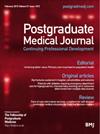Treatment of intracranial aneurysms using the Tubridge flow diverter.
IF 3.6
4区 医学
Q1 MEDICINE, GENERAL & INTERNAL
引用次数: 0
Abstract
OBJECTIVE The Tubridge flow diverter (TFD) was recently developed to treat intracranial aneurysm (IA). In this study, we aimed to assess the safety and efficacy of this novel device. METHODS A retrospective cohort of consecutive patients with IA was recruited between June 2017 and February 2022. The studied outcomes were perioperative complications, clinical quality of life, and angiographic IA occlusion. Multivariate logistic regression was performed to explore the potential predictors of perioperative stroke events and IA occlusion. A comprehensive literature review was conducted across five databases for evidence synthesis. RESULTS Among the patients with IA in our cohort, 144 underwent successful TFD implantation. Postoperative stroke was observed in 11 (7.6%) patients, and 130 (90.3%) patients were discharged with modified Rankin scales (mRS) of ≤2. In the last clinical follow-up (mean, 16.9 months), 96.6% of the patients reported a satisfactory quality of life (mRS ≤2). IA occlusion was observed in 84.6% of the patients at the last angiographic follow-up (mean, 10.4 months). Aneurysmal subarachnoid hemorrhage [odds ratio (OR), 6.98; 95% confidence interval (CI), 1.11-43.91] and giant IA (OR, 5.63; 95% CI, 1.15-27.48) were associated with perioperative stroke events. The evidence synthesis found high rates of satisfactory quality of life (rate, 98.8%; 95% CI, 97.1-99.9%) and IA obliteration (rate, 78.5%; 95% CI, 74.0-82.7%) after TFD treatment. The pooled complication rate was 13.6% (95% CI, 10.9-16.5%). CONCLUSIONS This study identified a high rate of IA occlusion in patients who received TFD treatment. These patients also reported a satisfactory quality of life. Further studies in larger prospective cohorts with longer follow-up periods are warranted to verify our findings. Key message What is already known on this topic Flow diverter (FD) devices are an optimal tool to modify hemodynamics and treat intracranial aneurysms (IAs). However, the safety and efficacy of a novel self-expanding FD, namely the Tubridge flow diverter (TFD), remain to be fully established owing to the short-term follow-up periods and limited sample size of existing studies. What this study adds In our cohort of patients who received TFD treatment, 96.6% of patients reported satisfactory quality of life at the last clinical follow-up (mean, 16.9 months); and 84.6% of IAs were successfully occluded at the last angiographic follow-up (mean, 10.4 months). Our comprehensive review and evidence synthesis of existing studies on TFD found high rates of satisfactory quality of life (98.8%; 97.1-99.9%) and IA obliteration (78.5%; 74.0-82.7%). How this study might affect research, practice or policy TFD demonstrated satisfactory performance in the treatment of IAs in our cohort. Studies with larger prospective cohorts and longer follow-up periods are warranted to further investigate this promising novel approach.使用 Tubridge 分流器治疗颅内动脉瘤。
目的最近开发出了用于治疗颅内动脉瘤(IA)的管桥血流分流器(TFD)。方法在 2017 年 6 月至 2022 年 2 月期间招募了一批连续的 IA 患者,对其进行回顾性队列研究。研究结果包括围手术期并发症、临床生活质量和血管造影IA闭塞情况。为了探索围手术期卒中事件和血管内闭塞的潜在预测因素,进行了多变量逻辑回归。我们在五个数据库中进行了全面的文献综述,以进行证据归纳。结果在我们的队列中,144 名 IA 患者成功接受了 TFD 植入术。11例(7.6%)患者术后出现中风,130例(90.3%)患者出院时改良Rankin量表(mRS)≤2。在最后一次临床随访中(平均 16.9 个月),96.6% 的患者表示生活质量令人满意(mRS ≤2)。在最后一次血管造影随访中(平均 10.4 个月),84.6% 的患者观察到动脉瘤闭塞。动脉瘤性蛛网膜下腔出血[比值比 (OR),6.98;95% 置信区间 (CI),1.11-43.91]和巨大 IA(OR,5.63;95% CI,1.15-27.48)与围手术期卒中事件相关。证据综述发现,TFD 治疗后生活质量满意率(98.8%;95% CI,97.1-99.9%)和 IA 清除率(78.5%;95% CI,74.0-82.7%)均较高。结论本研究发现,接受 TFD 治疗的患者中 IA 闭塞率较高。这些患者的生活质量也令人满意。为了验证我们的研究结果,有必要对随访时间更长、规模更大的前瞻性队列进行进一步研究。关键信息 关于该主题的已知信息 分流器(FD)是改变血流动力学和治疗颅内动脉瘤(IAs)的最佳工具。然而,由于现有研究的随访时间较短且样本量有限,新型自扩张分流器(即 Tubridge 分流器)的安全性和有效性仍有待充分确定。本研究的新发现 在我们接受 TFD 治疗的患者队列中,96.6% 的患者在最后一次临床随访(平均 16.9 个月)时对生活质量表示满意;在最后一次血管造影随访(平均 10.4 个月)时,84.6% 的 IAs 成功闭塞。我们对现有的 TFD 研究进行了全面回顾和证据综述,发现生活质量满意率(98.8%;97.1-99.9%)和 IA 闭塞率(78.5%;74.0-82.7%)都很高。本研究可能对研究、实践或政策产生的影响 在我们的队列中,TFD 在治疗 IA 方面表现令人满意。有必要对更大的前瞻性队列和更长的随访期进行研究,以进一步探讨这种前景广阔的新方法。
本文章由计算机程序翻译,如有差异,请以英文原文为准。
求助全文
约1分钟内获得全文
求助全文
来源期刊

Postgraduate Medical Journal
医学-医学:内科
CiteScore
8.50
自引率
2.00%
发文量
131
审稿时长
2.5 months
期刊介绍:
Postgraduate Medical Journal is a peer reviewed journal published on behalf of the Fellowship of Postgraduate Medicine. The journal aims to support junior doctors and their teachers and contribute to the continuing professional development of all doctors by publishing papers on a wide range of topics relevant to the practicing clinician and teacher. Papers published in PMJ include those that focus on core competencies; that describe current practice and new developments in all branches of medicine; that describe relevance and impact of translational research on clinical practice; that provide background relevant to examinations; and papers on medical education and medical education research. PMJ supports CPD by providing the opportunity for doctors to publish many types of articles including original clinical research; reviews; quality improvement reports; editorials, and correspondence on clinical matters.
 求助内容:
求助内容: 应助结果提醒方式:
应助结果提醒方式:


